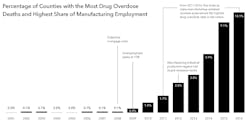Just as American manufacturing seems to be hitting its stride, the sector now faces the perfect storm when it comes to finding and developing the workforce of the future:
- Baby boomers are retiring from all sectors at a rate of 10,000 a day in the United States, taking their institutional and technical knowledge with them into retirement.
- The number of American youth with sufficient STEM education for a shop floor or R&D department is inadequate – and those who do have these skills typically do not entertain manufacturing as a career option, often favoring the tech sector.
- In recent years, the opioid crisis has reached critical levels, and a new report by the MAPI Foundation shows an ominous geographic overlap between U.S. manufacturing-centric regions and opioid abuse.
Let’s take a closer look at why these factors threaten to undermine the healthy manufacturing resurgence unless measures are taken to manage them.
Baby boom retirements. According to research from the Society for Human Resource Management, citing Bureau of Labor Statistics (BLS) data, the percentage of boomers retiring has doubled over the past eight years and will continue to increase until the last of the boomers reach 65 around 2030. This is particularly challenging for manufacturers. Not only are more than a quarter of manufacturing workers over the age of 55, but the BLS also notes that manufacturers have the highest tenure compared to other sectors. That translates into more institutional knowledge within the sector, which is now steadily declining, as is the productivity that these experts bring. In a survey of manufacturing HR professionals, 34% said this would be a real problem, and 11% said it would be a crisis by 2025.
STEM challenge. This baby boom vanishing act is made worse by the limited supply of STEM-educated students prepared to join the manufacturing sector. This is supported by the oft-cited study by Deloitte and the Manufacturing Institute predicting that over the next decade 2 million of the 3.5 million manufacturing jobs likely needed will go unfilled because of the skills gap.
One reason for this is clear: our schoolchildren are less skilled in this area than before. American 15-year-olds tested in the bottom half in math on the 2015 OECD Program for International Student Assessment (PISA) test and ranked 31 among the 35 industrial nations that participated. In science, the U.S. didn’t fare much better, ranking 35 out of the total pool of 72 nations and regions that participated.
Opioid predicament. Finally, as ominous as these trends are, the opioid crisis is poised to take a large toll on a much shorter term basis–not just on workforce productivity, but on society. A White House economic report observes that opioid abuse has already reached crisis proportions nationwide, with the nation spending 2.8% of its GDP to manage this serious health challenge. And a recent Brookings Institute study found that nearly half of prime working age men not in the labor force are taking daily doses of prescription pain medications.
The new MAPI Foundation study illustrates the speed with which the drug crisis has grown in manufacturing-centric counties. In 2008, the opioid crisis had a limited impact on counties with the highest share of manufacturing employment– 0.1% of these counties also saw the highest rates of drug overdose deaths. The acceleration began in earnest the following year. Then between 2011 and 2016, an average of 44% more manufacturing-centric counties per year joined the list of counties with the highest rates of overdose deaths. By the end of 2016, 70 counties that rely the most on manufacturing employment, located across 20 states, were grappling with deadly addiction.
Another 201 counties that have the highest share of manufacturing employment are seeing higher than the national median of drug overdose deaths as well. Put another way, 40% of the country’s manufacturing-centric counties are experiencing the worst of the drug crisis. Based on the historical trends, it is safe to say that in the next few years, many of these counties will find themselves in a deeper crisis.
The American manufacturing sector has come a long way since its collapse during the financial crisis, with the MAPI Foundation now projecting average growth of 2.8% between 2018 and 2021. If the sector hopes to sustain such growth in the coming decade, the workforce challenges, especially the growing opioid crisis, must be addressed.






